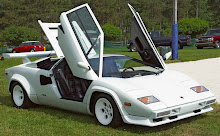So this is what George Lucas did between Star Wars installment one and two.

The Bartini Beriev is a version of a Russian EKRANOPLAN— a bizarre cross between a hovercraft and an airplane developed during the cold war. They hover and skim above the water surface at speeds of up to 250 miles an hour carrying heavier loads of cargo and troops than any airplane - the Ekranoplans, or "Wing-in-Ground" (WIG) vehicles are possibly the most exciting and strange looking technology ever designed by men or alien alike.

Developed mostly by Soviets during Cold Wars years (by Rostislav Alexeev's design firm) some of them were over 500 feet in length and had an estimated weight of over 500 tons! And yet they skimmed over the waves with grace, at high speeds, able to negotiate stormy conditions, unseen by radar - all thanks to an aerodynamic principle known as the "ground effect".

All pilots are familiar with this effect: when an airplane is about to land, it almost wants to "float" on air, moments before touchdown. The compressed air between the wing and the ground becomes a "cushion" that gives the plane smooth gliding ability. Over the sea surface this effect is even more noticeable.
Russian "Caspian Sea Monster" Ekranoplan

The biggest ground-effect vehicle ever designed (100 meters long, weight: 544 tons, powered by ten Dobryin VD-7 turbojet engines). It still holds the record for lifting the heaviest load off the ground. It also had an air of mystery around it for a long time, tested in secrecy on the Caspian Sea in 1966 and spied on by a US satellite. After an accidental crash (due mostly to poor visibility in the fog), KM was abandoned in a shallow 20 meters of water, thwarting all efforts to recover it because of its weight; its high tail sticking out of the water like a funeral cross.
Some more Ekranoplan models:



 Pop goes the egotistic James Bond alter-ego as you press a button to summon your Porsche from the depths of hell.
Pop goes the egotistic James Bond alter-ego as you press a button to summon your Porsche from the depths of hell. They don’t come cheap though. First you have to be on waiting the list which is currently four months long. It takes 10 weeks to build and will cost you up to $61,181 depending your customization. Add another car ontop and it will be $72,816. Chump change when you think of the effect it will have on passing squirrels.
They don’t come cheap though. First you have to be on waiting the list which is currently four months long. It takes 10 weeks to build and will cost you up to $61,181 depending your customization. Add another car ontop and it will be $72,816. Chump change when you think of the effect it will have on passing squirrels.















